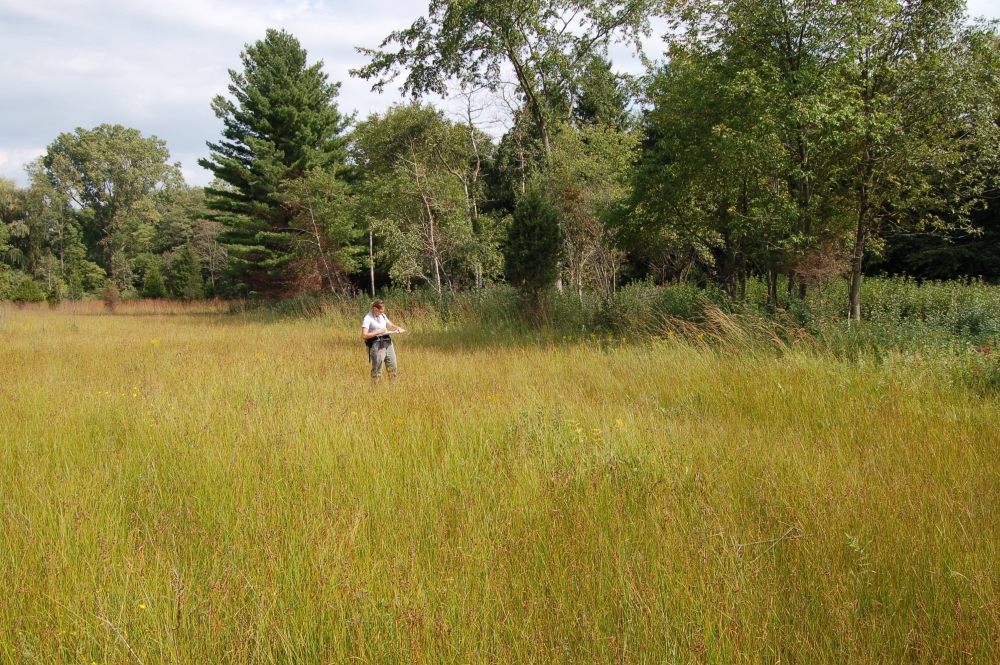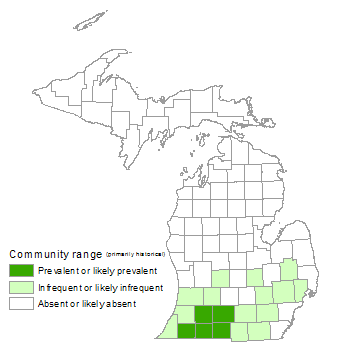Wet Prairie
Overview
Wet prairie is a native lowland grassland occurring on level, saturated and/or seasonally inundated stream and river floodplains, lake margins, and isolated depressions in southern Lower Michigan. It is typically found on outwash plains and channels near moraines. Soils are primarily loam or silt loam of neutral pH and have high organic content. Dominant species include bluejoint grass (Calamagrostis canadensis) and cordgrass (Spartina pectinata), with sedges (Carex spp.) often important subdominants.
Rank
Global Rank: G3 - Vulnerable
State Rank: S1 - Critically imperiled

Landscape Context
Wet prairie occurs on outwash plains and channels, typically near coarse-textured moraines, within stream or river floodplains, lake margins, and isolated depressions. It is associated with uplands characterized by dry and dry-mesic southern forests, and prior to European settlement, with savanna and prairie communities such as oak openings, oak barrens, mesic prairie, and dry-mesic prairie.
Soils
Soils are typically sandy loam or silt loam but can also be silty clay or clay. Soils are characterized by neutral pH, high organic content, and good water-retaining capacity. Organic deposits (muck) are absent or form only a thin layer over mineral soil.
Natural Processes
Water level fluctuations and fire help maintain diversity and open conditions. Seasonal saturation or inundation through flooding, ponding, or high water tables restricts shrub and tree establishment. Beaver can reduce shrub and tree cover by causing flooding, raising local water tables, and through herbivory. Prior to European settlement in the early 1800s, fires of natural and anthropogenic origin limited encroachment by shrubs and trees that established despite the unfavorable hydrologic conditions. Fire helps maintain species diversity by facilitating seed germination, opening microsites for seedling establishment and growth of small species, and releasing important plant nutrients that bolster plant growth, flowering, and seed set.
Vegetation
Dominant grasses are bluejoint grass and cordgrass, with sedges (Carex stricta and C. bebbii) often important subdominants. Big bluestem (Andropogon gerardii) and Indian grass (Sorghastrum nutans) may appear in areas transitional to wet-mesic prairie. Other characteristic species include hog-peanut (Amphicarpaea bracteata), angelica (Angelica atropurpurea), groundnut (Apios americana), fringed brome (Bromus ciliatus), marsh marigold (Caltha palustris), common boneset (Eupatorium perfoliatum), joe-pye-weed (Eutrochium maculatum), fowl manna grass (Glyceria striata), tall sunflower (Helianthus giganteus), star-grass (Hypoxis hirsuta), marsh pea (Lathyrus palustris), Michigan lily (Lilium michiganense), fringed loosestrife (Lysimachia ciliata), starry false Solomon’s seal (Maianthemum stellatum), swamp saxifrage (Micranthes pensylvanica), leafy satin grass (Muhlenbergia mexicana), cowbane (Oxypolis rigidior), Virginia mountain mint (Pycnanthemum virginianum), black-eyed Susan (Rudbeckia hirta), tall goldenrod (Solidago altissima), Canada goldenrod (S. canadensis), late goldenrod (S. gigantea), Riddell’s goldenrod (S. riddellii), New England aster (Symphyotrichum novae-angliae), purple meadow rue (Thalictrum dasycarpum), marsh fern (Thelypteris palustris), and broad-leaved cat-tail (Typha latifolia). Common shrubs include dogwoods (Cornus spp.), ninebark (Physocarpus opulifolius), and willows (Salix spp.); these may be dense due to fire suppression and/or hydrologic alteration. The invasive species, reed canary grass (Phalaris arundinacea), is common in some sites. Diversity varies, in part depending on duration of seasonal inundation, time since last fire, and abundance of invasive species.
For information about plant species, visit the Michigan Flora website.
Plant Lists
Graminoids
- big bluestem (Andropogon gerardii)
- fringed brome (Bromus ciliatus)
- blue-joint (Calamagrostis canadensis)
- sedges (Carex buxbaumii, C. pellita, C. stricta, and others)
- fowl manna grass (Glyceria striata)
- leafy satin grass (Muhlenbergia mexicana)
- Indian grass (Sorghastrum nutans)
- cordgrass (Spartina pectinata)
Forbs
- swamp agrimony (Agrimonia parviflora)
- hog-peanut (Amphicarpaea bracteata)
- angelica (Angelica atropurpurea)
- groundnut (Apios americana)
- marsh-marigold (Caltha palustris)
- hedge bindweed (Calystegia sepium)
- marsh bellflower (Campanula aparinoides)
- common boneset (Eupatorium perfoliatum)
- joe-pye-weed (Eutrochium maculatum)
- tall sunflower (Helianthus giganteus)
- star-grass (Hypoxis hirsuta)
- marsh pea (Lathyrus palustris)
- Michigan lily (Lilium michiganense)
- fringed loosestrife (Lysimachia ciliata)
- starry false Solomon-seal (Maianthemum stellatum)
- swamp saxifrage (Micranthes pensylvanica)
- cowbane (Oxypolis rigidior)
- swamp-betony (Pedicularis lanceolata)
- common mountain mint (Pycnanthemum virginianum)
- black-eyed Susan (Rudbeckia hirta)
- tall goldenrod (Solidago altissima)
- Canada goldenrod (Solidago canadensis)
- late goldenrod (Solidago gigantea)
- Riddell’s goldenrod (Solidago riddellii)
- New England aster (Symphyotrichum novae-angliae)
- purple meadow-rue (Thalictrum dasycarpum)
- broad-leaved cat-tail (Typha latifolia)
- golden alexanders (Zizia aurea)
Ferns
- sensitive fern (Onoclea sensibilis)
- marsh fern (Thelypteris palustris)
Shrubs
- dogwoods (Cornus spp.)
- shrubby cinquefoil (Dasiphora fruticosa)
- ninebark (Physocarpus opulifolius)
- willows (Salix spp.)
- meadowsweet (Spiraea alba)
Noteworthy Animals
Beaver can cause flooding that substantially alters wetlands and results in conversion of southern shrub-carr and lowland forest systems to ponds, emergent marsh, southern wet meadow, wet prairie, or wet-mesic prairie, depending on landscape position, soils, and depth and duration of flooding.
Rare Plants
- Dodecatheon meadia (shooting star, state endangered)
- Eryngium yuccifolium (rattlesnake-master, state threatened)
- Mimulus alatus (wing-stemmed monkey-flower, presumed extirpated from Michigan)
- Polemonium reptans (Jacob’s ladder, state threatened)
- Pycnanthemum muticum (broad-leaved mountain mint, state threatened)
- Sanguisorba canadensis (Canadian burnet, state threatened)
- Silphium integrifolium (rosinweed, state threatened)
- Sisyrinchium farwellii (Farwell’s blue-eyed-grass, presumed extirpated from Michigan)
Rare Animals
- Acris crepitans blanchardi (Blanchard’s cricket frog, state special concern)
- Ambystoma texanum (smallmouth salamander, state endangered)
- Ammodramus savannarum (grasshopper sparrow, state special concern)
- Asio flammeus (short-eared owl, state endangered)
- Botaurus lentiginosus (American bittern, state special concern)
- Circus cyaneus (northern harrier, state special concern)
- Clemmys guttata (spotted turtle, state threatened)
- Clonophis kirtlandii (Kirtland’s snake, state endangered)
- Dorydiella kansana (leafhopper, state special concern)
- Emydoidea blandingii (Blanding’s turtle, state special concern)
- Flexamia reflexus (leafhopper, state special concern)
- Meropleon ambifusca (Newman’s brocade, state special concern)
- Neoconocephalus lyristes (bog conehead, state special concern)
- Neoconocephalus retusus (conehead grasshopper, state special concern)
- Neonympha m. mitchellii (Mitchell’s satyr, federal/state endangered)
- Orchelimum concinnum (red-faced meadow katydid, state special concern)
- Orphulella pelidna (green desert grasshopper, state special concern)
- Papaipema cerina (golden borer, state special concern)
- Papaipema maritima (maritime sunflower borer, state special concern)
- Papaipema speciosissima (regal fern borer, state special concern)
- Paroxya hoosieri (Hoosier locust, state special concern)
- Phalaropus tricolor (Wilson’s phalarope, state special concern)
- Sistrurus c. catenatus (eastern massasauga, federal candidate species and state special concern)
- Spartiniphaga inops (spartina moth, state special concern)
- Spiza americana (dickcissel, state special concern)
- Tyto alba (barn owl, state endangered)
Biodiversity Management Considerations
The majority of wet prairie acreage was converted to agriculture following European settlement. Threats to remaining sites include hydrologic alteration, nutrient enrichment, siltation, fire suppression, shrub and tree encroachment, and destruction of upland buffers. Fire suppression and hydrologic alterations such as ditching and tiling promote shrub and tree invasion, which results in reduced cover of graminoids and the fine-fuels needed to carry a fire. Invasive plants are favored by nutrient enrichment, fire suppression, and hydrologic alteration. Invasive species that threaten the diversity and community structure of wet prairie include glossy buckthorn (Frangula alnus), multiflora rose (Rosa multiflora), autumn olive (Elaeagnus umbellata), reed (Phragmites australis subsp. australis), reed canary grass (Phalaris arundinacea), narrow-leaved cat-tail (Typha angustifolia), hybrid cat-tail (Typha xglauca), and purple loosestrife (Lythrum salicaria). Prescribed fire, in conjunction with cutting and/or herbiciding of invasive species, can be used to maintain biodiversity of lowland grasslands. Some sites may require hydrologic restoration and efforts to restrict nutrient and sediment inputs. In addition, restoration of upland natural communities bordering wet prairie occurrences should be conducted to improve hydrology and provide refugia for flood-intolerant species during periods of high water.
Variation
Species dominance varies among bluejoint, cordgrass, sedges, and native forbs. Some occurrences are associated with seasonal flooding, others apparently flood only rarely or not at all. Sites with big bluestem and/or Indian grass as dominants or subdominants may represent wet-mesic prairie.
Similar Natural Communities
Wet-mesic prairie, lakeplain wet prairie, lakeplain wet-mesic prairie, wet-mesic sand prairie, and southern wet meadow.
Places to Visit
- Turner Creek Wet Prairie, Barry State Game Area, Barry Co.
- Waterloo Wet Prairie, Waterloo State Recreation Area, Jackson Co.
Relevant Literature
- Chapman, K.A. 1984. An ecological investigation of native grassland in southern Lower Michigan. M.A. thesis, Western Michigan University, Kalamazoo, MI.
- Fraser, A., and K. Kindscher. 2005. Spatial distribution of Spartina pectinata transplants to restore wet prairie. Restoration Ecology 13: 144-151.
- Galatowitsch, S.M., D.C. Whited, R. Lehtinen, J. Husveth, and K. Schik. 2000. The vegetation of wet meadows in relation to their land-use. Environmental Monitoring and Assessment 60: 121-144.
- Kercher, S.M., and J.B. Zedler. 2004. Flood tolerance in wetland angiosperms: A comparison of invasive and noninvasive species. Aquatic Botany 80: 89-102.
- Kercher, S.M., and J.B. Zedler. 2004. Multiple disturbances accelerate invasion of reed canary grass (Phalaris arundinacea L.) in a mesocosm study. Oecologia 138: 455-464.
- NatureServe. 2006. NatureServe Explorer: An online encyclopedia of life [Web application]. Version 6.1. NatureServe, Arlington, VA. Available http://www.natureserve.org/explorer. (Accessed: January 3, 2007.)
- Thompson, P.W. 1968. A wet prairie community in Ann Arbor, Michigan. Michigan Academician 2: 87-94.
For a full list of references used to create this description, please refer to the natural community abstract for Wet Prairie.
More Information
Citation
Cohen, J.G., M.A. Kost, B.S. Slaughter, D.A. Albert, J.M. Lincoln, A.P. Kortenhoven, C.M. Wilton, H.D. Enander, and K.M. Korroch. 2020. Michigan Natural Community Classification [web application]. Michigan Natural Features Inventory, Michigan State University Extension, Lansing, Michigan. Available https://mnfi.anr.msu.edu/communities/classification. (Accessed: January 1, 2026).
Kost, M.A., D.A. Albert, J.G. Cohen, B.S. Slaughter, R.K. Schillo, C.R. Weber, and K.A. Chapman. 2007. Natural Communities of Michigan: Classification and Description. Michigan Natural Features Inventory, Report No. 2007-21, Lansing, MI.


